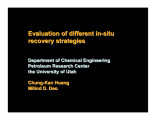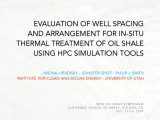TO
Filters: Collection: "ir_eua"
| Title | Date | Subject | Description | ||
|---|---|---|---|---|---|
| 801 |
 |
Evaluation Committee Report: 1996 Full-scale evaluation | 1996 | Accreditation; Higher Education, University of Utah | Final report of the evaluation committee for the 1996 accreditation of the University of Utah |
| 802 |
 |
Evaluation Committee, October 9-11, 2006 | 2006-09-26 | Accreditation; Higher Education, University of Utah | Northwest Commission of Colleges and Universities Evaluation Committee |
| 803 |
 |
Evaluation of an eastern shale oil residue as an asphalt additive | 1995-09 | eastern shale oil; shale oil residue; asphalt additives | An evaluation of eastern shale oil (ESO) residue as an asphalt additive to reduce oxidative age hardening and moisture susceptibility was conducted by Western Research Institute (WRI). The ESO residue, having a viscosity of 23.9 Pa-s at 60°C (140°F), was blended with three different petroleum-deri... |
| 804 |
 |
Evaluation of Blue Blocking Intraoculalr Lenses Including a New Photochromatic IOL | 2007-03-14 | Blue Blocking; Yellow IOL; Photochromatic IOL; Night Vision; Macular Degeneration | This movie introduces photochromatic IOLs and compares them to blue blocking IOLs. It discusses the benefits photochromatic IOLs provide such as improved night vision and protection of the macula. |
| 805 |
 |
Evaluation of different in-situ recovery strategies | 2006-10 | in-situ recovery strategies; in-situ recovery; oil shale; thermal simulator; oil shale reservoirs; in-situ combustion; in-situ pyrolysis; modified in-situ process | Analysis of different in-situ production strategies from oil shale using a general purpose thermal simulator. |
| 806 |
 |
Evaluation of oil shale bitumen as a pavement asphalt additive to reduce moisture damage susceptibility | 1991-01 | oil shale bitumen; pavement asphalt additive; moisture damage susceptibility; bitumen | An unrefined shale bitumen was evaluated as an agent to reduce moisture damage susceptibility of asphalt aggregate mixtures. Some activity was observed but less than might have been expected based on the molecular weight and nitrogen content of the bitumen. The countereffects of free carboxylic acid... |
| 807 |
 |
Evaluation of the potential end use of oils produced by the ROPE® process from California tar sand | 1989-12 | ROPE process oils; California tar sand; tar sand; oil products | The oil products from Process Development Unit (PDU) run SPR--111 were evaluated for potential end use. This particular run was a fiveday test using Arroyo Grande tar sand from California as the feed to the PDU. The distillate from knockout #2 was hydrotreated to produce a series of process intermed... |
| 808 |
 |
Evaluation of the Utah oil sand resource | 1976-08 | oil sand deposits; Utah oil sand; oil sand resource; Tar Sand Triangle; P. R. Spring; Sunnyside deposits; hydrocarbons; surface mining of oil sands | The three largest oil sand deposits in Utah, namely, the Tar Sand Triangle, the P.R. Spring, and the Sunnyside deposits, have been studied to contribute data relative to the surface and insitu mining of these deposits and to recommend research that should be conducted to develop the Utah oil sand re... |
| 809 |
 |
Evaluation of well spacing and arrangement for in-situ thermal treatment of oil shale using HPC simulation tools | 2014-10 | well spacing; in-situ thermal treatment; oil shale; HPC simulation tools; oil shale resources; oil sands resources; basin scale simulation; liquid fuel production | The mission of this presentation is to pursue research that improves industry's ability to utilize the vast energy stored in oil shale and oil sands resources with minimal environmental impact. Three main research areas looked at are: 1. Basin scale simulation of environmental and economic impacts o... |
| 810 |
 |
EX-1 Plate 3 | 2014 | plate 3; well log; Green River Formation; core log | |
| 811 |
 |
Experimental and modeling study of particulate formation in high-pressure diesel-like conditions | 2000 | particulate formation; high-pressure diesel-like conditions; diesel combustion process; tailpipe particulate emissions | The diesel combustion process has been characterized by combined measurements of flame intensity and extinction in the UV-visible range in an optically accessible divided-chamber diesel engine at different air/fuel ratios and constant engine speed, using n-heptane and commercial diesel oil as fuels.... |
| 812 |
 |
Experimental evaluation of the effects of quench rate and quartz surface area on homogeneous mercury oxidation | 2007 | quench rate; quartz surface area; homogeneous mercury oxidation; mercury chemistry | This paper presents a mercury oxidation data set suitable for validation of fundamental kinetic models of mercury chemistry and for mechanism development. Experimental facilities include a mercury reactor fitted with a 300-W, quartz-glass burner and a quartz reaction chamber. While operated with a t... |
| 813 |
 |
Experimental investigation for the development of burners for low scale reheating of semi-finished metal products | 2019 | recuperative burner; fuel rich combustion; direct fired furnace; scale reduction; radiant tube | Industrial furnaces for the reheating of semi-finished metal products are often direct fired with natural gas and air. Oxidation of the metals exposed to the furnace atmosphere causes significant material losses and additional work during furnace operation and in further processing. A reheating conc... |
| 814 |
 |
Explaining the "three inch rule": why model flares don't match full-scale | 2022 | It was Pohl and co-workers who discovered the so-called "Three Inch Rule" in their work on flares in the 1980s. They found that model flares with pipe diameter less than three inches do not have the same Combustion Efficiency (CE) and stability behaviour as full-scale flares, at least when wind is n... | |
| 815 |
 |
Exploring human heredity: the twentieth annual Frederick William Reynolds Lecture. | 1956 | Human heredity | Whether or not we think of man as the newest form of a continually changing organism which dates back millions of years, a product of natural selection which constantly preserves the better adapted and eliminates the less fit, he stands before us as an extremely complex organism in which are carried... |
| 816 |
 |
The extraction of bitumen from western oil sands | 1994-03 | bitumen extraction; western oil sands; oil sands; final report; oil sand recovery technologies; environmental impacts; health and safety procedures | The information required for compliance with the National Environmental Protection Act (NEPA) has been documented in this section. This final report has been prepared to reflect the research and development activities performed under the cooperative agreement 89MC26268 between the University of Utah... |
| 817 |
 |
The extraction of bitumen from western oil sands | Oil Sand Research and Development program; oil sand; bitumen; PR Spring oil sand deposit; bitumen extraction | The information required for compliance with the National Environmental Protection Act (NEPA) has been documented in this section. This final report has been prepared to reflect the research and development activities performed under the cooperative agreement 89MC26268 between the University of Utah... | |
| 818 |
 |
The extraction of bitumen from western oil sands | 1993-07 | bitumen extraction; western oil sands; oil sands; bitumen recovery | Tasks are referenced to Part II - Statement of Cooperative Agreement Objectives of contract noted above. This report cites Task number followed by brief restatement of each Task as stipulated in the contract, followed by Action this Quarter. |
| 819 |
 |
The extraction of bitumen from western oil sands: Volume 1 | 1997-11-26 | oil sand research and development; bitumen surface tension; Utah bitumens | The Oil Sand Research and Development Group at the University of Utah revised and updated the environmental assessment of the impact of projected program-related activities for the 1994-1996 contract period in accordance with the requirements of the National Environmental Policy Act. |
| 820 |
 |
The extraction of bitumen from western oil sands: Volume 2 | 1997-11-26 | bitumen extraction; western oil sands; oil sands; synthetic fuels; natural bitumen; thermally-coupled fluidized-bed tar sands extraction process | In these days of plentiful fuel supplies, synthetic fuels are not in demand; but with the current rate of consumption of oil the importance of synthetic fuels will only increase. The United States currently imports 50% of its transportation fuel and such a dependence could be potentially dangerous, ... |
| 821 |
 |
Extraction of hydrocarbons from Antrim oil shale | 1978 | hydrocarbon extraction; Antrim oil shale; oil shale; hydrocarbon recovery | The Dow Chemical Company has performed a variety of in situ experiments on the Antrim oil shale which underlies Michigan. These experiments have ranged from in situ combustion in a quarry to attempted extraction at a depth of 2,600 feet (780 m). Currently, Dow is continuing its efforts to obtain hyd... |
| 822 |
 |
Fall 2020 Instructional Guidelines | 2020-07 | COVID-19; instruction; campus | Fall 2020 Instructional Guidelines |
| 823 |
 |
Fast-tracking Wasatch Front transit investments: economic and demographic impacts of a 2025 build-out | 2011 | Over the next 30 years, the Wasatch Front will significantly expand its transit network. Plans include the construction of an additional 25 miles of light rail, 76 miles of commuter rail, 227 miles of bus rapid transit, and 29 miles of mountain transportation rail line. These projects will be built ... | |
| 824 |
 |
The fate of char-N at pulverized coal conditions | 2003 | char-N; pulverized coal conditions; pulverized coal; coal char. | The fate of char-N (nitrogen removed from the coal matrix during char oxidation) has been widely studied at fluidized bed conditions. This work extends the study of char-N to pulverized coal conditions. Coal chars from five parent coals were prepared and burned in a laboratory-scale pulverized coal ... |
| 825 |
 |
Feasibility of heavy-oil recovery | 1987-11-02 | heavy oil recovery; domestic liquid fuel; heavy oil reservoirs | This paper presents the results of a study completed in June 1984 that assessed the size, technical categorization, and potential of the U.S. heavy-oil resource base. Based on a proprietary data base containing nearly 1100 heavy oil reservoirs, the study concluded that heavy-oil resources in place i... |
